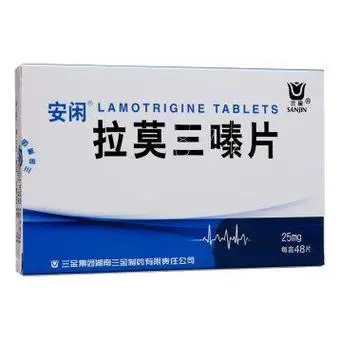Lamotrigine Dispersible Tablets.
Effects and efficacy: This product is mainly used for simple partial seizures, complex partial seizures, secondary generalized tonic-clonic seizures, and primary generalized tonic-clonic seizures. It can also be used to treat epileptic seizures associated with Lennox-Gastaut syndrome. It can be used as a monotherapy for children over 12 years old and adults. It is not recommended to use monotherapy for children under 12 years old at present, because the corresponding data of controlled trials for this special target population have not been obtained. Children over 2 years old and adults can be added to the therapy. Dosage and administration: Oral, can be chewed or swallowed directly, or dissolved in a small amount of water and taken. To ensure the maintenance of the therapeutic dose, the patient’s weight needs to be monitored and the dose should be checked when the weight changes. When other combined antiepileptic drugs are discontinued and this product is used as a monotherapy or other antiepileptic drugs are added to the add-on treatment regimen of this product, the above changes should be considered. The effect of the pharmacokinetics of lamotrigine should be considered. Monotherapy dose for adults and children over 12 years old, the initial dose of this product for monotherapy is 25 mg, once a day, for two weeks; followed by 50 mg, once a day, for two weeks. After that, the dose is increased every 1-2 weeks, with a maximum increase of 50-100 mg until the best effect is achieved. The maintenance dose for the best effect is usually 100-200 mg/day, administered once or twice a day. However, some patients need to take 500 mg of lamotrigine daily to achieve the desired effect. Add-on therapy dosage for adults and children over 12 years old For patients taking sodium valproate, regardless of whether they take other antiepileptic drugs, the initial dose of this product is 25 mg, taken every other day for two weeks; once a day for the next two weeks, 25 mg each time. After that, the dose should be increased every 1-2 weeks, with a maximum increase of 25-50 mg, until the best effect is achieved. The maintenance dose for the best effect is usually 100-200 mg per day, taken once or twice. For patients taking enzyme-inducing antiepileptic drugs, regardless of whether they take other antiepileptic drugs (except sodium valproate), the initial dose of this product is 50 mg, once a day for two weeks; 100 mg per day for the next two weeks, taken twice. Thereafter, the dose is increased every 1-2 weeks, with a maximum increase of 100 mg until the best effect is achieved. The maintenance dose for best effect is usually 200-400 mg per day, taken in two divided doses. Some patients need to take 700 mg of this product daily to achieve the desired effect. In patients using other drugs that do not significantly inhibit or induce lamotrigine glucuronidation, the initial dose of this product is 25 mg once a day for two consecutive weeks; 50 mg once a day for the next two weeks. Thereafter, the dose level is increased every 1-2 weeks, with an increase of 50-100 mg/day, and the dose should be increased to achieve the best effect. The maintenance dose for best effect is usually 100-200 mg/day, taken once a day or twice a day. For children (2-12 years old) taking sodium valproate with or without any other antiepileptic drugs, the initial dose of this product is 0.15 mg/kg/day, taken once a day for two consecutive weeks; 0.3 mg/kg once a day for the next two weeks. Thereafter, the dose should be increased every 1-2 weeks, with a maximum increase of 0.3 mg/kg, until the best therapeutic effect is achieved. The maintenance dose that usually achieves the best therapeutic effect is 1-5 mg/kg/day, taken once or twice. For patients who are taking antiepileptic drugs (AEDs) or other drugs that induce lamotrigine glucuronidation, with or without other antiepileptic drugs (except sodium valproate), the initial dose of this product is 0.6 mg/kg/day, taken twice for two consecutive weeks; the dose for the next two weeks is 1.2 mg/kg/day, taken twice. Thereafter, the dose should be increased every 1-2 weeks, with a maximum increase of 1.2 mg/kg, until the best therapeutic effect is achieved. The maintenance dose that usually achieves the best therapeutic effect is 5-15 mg/kg/day, taken twice. In order to obtain an effective maintenance treatment dose, the child’s weight must be monitored and the dosage must be re-evaluated based on changes in weight. In patients using other drugs that do not significantly inhibit or induce lamotrigine glucuronidation, the initial dose of this product is 0.3 mg/kg/day, taken once or twice a day for two weeks, followed by 0.6 mg/kg/day, taken once or twice a day for two weeks. Thereafter, the dose is increased every 1-2 weeks, with a maximum daily increase of 0.6 mg/kg/day until the best therapeutic effect is achieved. The maintenance dose for the best therapeutic effect is usually 1-10 mg/kg per day, taken once or twice a day, with a maximum daily dose of 200 mg. The maintenance dose required for patients aged 2-6 years can be at the upper end of the recommended dose range. Children under 2 years old There is not enough information on the use of this product for children under 2 years old, so lamotrigine tablets are not recommended for children under 2 years old.
Drug contraindications:
Allergy to this product is prohibited
Related dosage forms:
Tablets, dispersible tablets
Share:
Products
Our offers
Health Classification
Let us work together to protect precious health



























